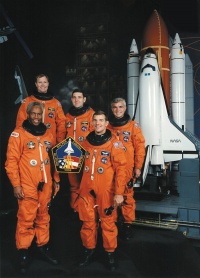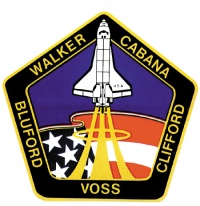STS-53
From The Space Library
 | |
| Organization | NASA-OfficeofSpaceFlight(UnitedStates),DepartmentofDefense-DepartmentoftheAirForce(UnitedStates) |
|---|---|
| Mission type | Earth Science,Human Crew |
| Launch date | December 2, 1992 |
| Launch vehicle | Space Shuttle |
| Carrier rocket | {$Carrier Rocket} |
| Launch site | Cape Canaveral, United States |
| COSPAR ID | 1992-086A |
| Mass | {$Mass} |
| Experiments | Here |
| Alternate Names | STS 53/DoD 1,STS/DoD 1,22259 |
| Nominal Power | {$Nominal Power} |
| Additional Information | Here |
| PDMP Information | Here |
| Telecommunications Information | Here |
| Data Collection | Here |
| Payload Mass Up | 11868.0 kg |
The STS-53 Space Shuttle "Discovery" mission is a dedicated Department of Defense (DoD) mission and carried the DoD-1 classified payload. In addition, several non-classified DoD experiments were carried out. The Space Shuttle "Discovery" had been completely refurbished and modified. The secondary unclassified experiments include: (1) Shuttle Glow (GLO), to investigate Shuttle/space environment interactions; (2) Cryogenic Heat Pipe Experiment (CRYOHP), a joint DoD and NASA Hitchhiker experiment to test advanced technology to regect excess heat generated by infrared sensors; (3) Orbital Debris Radar Calibration System (ODERACS), an experiment which will release 6 calibrated spheres into orbit in order to provide a source for fine-tuning ground-based radar facilities around the world; (4) Battlefield Laser Acquisition Sensor Test (BLAST), an Army space project to demonstrate the use of spaceborne laser receivers to detect laser energy from ground test locations; (5) Cloud Logic to Optimize Use of Defense System (CLOUDS), a meteorological experiment to quantify the variation in apparent cloud cover as a function of orbital view angle; (6) Cosmic Radiation Effects and Activation Monitor (CREAM), an experiment designed to collect cosmic ray energy loss spectra, neutron fluxes, and induced radioactivity; (7) Fluid Acquisition and Resupply Equipment (FARE), an experimen t to investigate the dynamics of fluid transfer in space; (8) Hand-held, earth-oriented, Real-time, Cooperative, User-friendly, Location-targeting and Environmental System (HERCULES), a Naval Research Lab (NRL) experiment to enable a Shuttle astrionaut to point a camera at an Earth feature, record the image and determine the latitude and longitude of the feature; (10) Microencapsulation In Space (MIS), designed to incresae the knowledge of microencapsulated drug technology; (11) Radiation Monitoring Equipment -III (RME-III), an instrument to measure the exposure to ionizing radiation on the Shuttle; (12) Space Tissue Loss (STL), to study the effects of space on fragile life systems; and (13) Visual Function Tester - Model II (VFT-2), a series of vision performance experiments in space.

